| Botanical Name |
|
| Family |
Asteraceae - The daisy family. |
| Pronunciation |
ark-TO-tis sto-ee-ka-dee-FOH-lee-a |
| Common Name(s) |
Afrikaans: kusgousblom; Bietou; Bitterbossie; Bittergousblom; Gousblom; Wildemagriet; Witgousblom
|
| Plant Group |
- Ground Cover A plant with a low-growing, spreading habit, grown specifically to cover the ground.
- Perennial A plant whose life cycle lasts for three or more seasons.
|
| Plant Size |
- Small to Medium
| Tree | 8m to 15m |
| Shrub | 75cm to 1m |
| Perennial/ground cover | 20cm to 40cm |
| Bulb | 30cm to 40cm |
| Succulent | 20cm to 40cm |
|
| Position |
- Sun The area is in full sun for all or most of the day, all year round.
|
| General Information |
- Drought Tolerance: High The plant is well adapted to arid conditions; it can survive long periods of drought and high temperatures without extra water.
- Evergreen Plants that have leaves all year round.
- Frost: Half-hardy The plant is able to survive low temperatures and some frost but requires protection against severe frost.
- Salt spray tolerant A plant with specific adaptations enabling it to grow in a saline environment.
- Sand tolerant Plants adapted to survive in nutrient poor, very sandy soils.
- Water Wise Plant species originating from low rainfall regions that require less water to survive and thrive than other plant species.
- Wind Tolerant Plants able to withstand the effect of strong winds.
|
| Specific Information |
Arctotis stoechadifolia is an aggressive fast-growing sprawling perennial that hugs the ground and forms a silver-grey carpet with stems that root where they are in contact with the ground. The long narrow leaves are soft and woolly with slightly toothed or serrated edges. They give off a bitter-sweet smell when touched. The large daisy-like flowers only open in full sun.
Arctotis stoechadifolia has become a problem plant In California and particularly in Southern Australia, where it has been used as a coastal sand-stabilizing plant. It has become a weed as it invades natural areas resulting in a loss of species indigenous to these areas.
|
| Ad Break |
|
| Flowers |
| Description |
daisy with petals marked below with red or maroon
|
| Season |
- Spring to Summer Plants will seldom bloom for the entire season as given in the list, but should flower during a period within these parameters.
|
| Colour |
|
| Growth Rate |
- Very Fast Specifying growth rate can be very misleading as there is considerable variation of growth rate depending on type and species of plant, available water, supplementary feeding, mulching and general care, as well as the plants suitability and adaptability to the garden environment.
|
| Plant Uses |
- Attracts bees, butterflies or other insects This plant attracts insects which can be food for birds or other creatures in your garden.
- Foliage Plant Plants grown because their foliage is colorful or unique. Many of these plants have insignificant flowers.
- Ground Cover Low-lying plants that spread fast, require minimal maintenance, and cover large expanses or bare areas between bulbs or shrubs. They provide protection from erosion and drought and improve the visual appearance of the garden.
- Mass Planting Plants useful for filling a large area with just one or a few kinds of plants spaced close together. Creates a bold, dramatic effect and to reduces maintenance.
- Pioneer for new gardens A very fast growing plant, able to withstand hardship, that can be used to populate land that has recently been cleared of natural vegetation. These plants pave the way for slower-growing species by adding nutrients to the soil and creating leaf litter.
- Retaining Walls Shallow rooted plants for cascading over dry stone walls or planting in hollow spots in retaining blocks.
- Rock Garden An area constructed of larger rocks, arranged naturally, to emphasise the use of stones as a main element. Generally plants used do not need a lot of care.
- Stabilize Banks Plant is used to prevent soil erosion because their roots will form a mat that stabilizes the soil and keeps it from washing away in heavy rains.
- Suitable for coastal gardens Plants adapted to dry, sandy soil, forceful wind, limited rainfall and intense sunlight.
- Suitable for seaside gardens Plants that will survive the hostile environment of harsh salty winds, dry sandy soil, irregular rainfall and heat found in seaside gardens.
|
| Distribution and Habitat |
in the Western Cape in a strip along the West Coast from Langebaan to the Cape Peninsula, on dunes and sandy flats
|
| Planting Suggestions |
Arctotis stoechadifolia is easy to grow but must be planted in full sun in well drained soil. Cuttings can be made throughout the year and rooted in a tray filled with well-drained sand after which they can be planted directly into the garden beds, especially during the cooler winter months.
I have found that there is seldom a need for pre-rooting: I either place the cuttings straight into the garden where I want them, or cut off and replant stem cuttings that have already rooted along the ground.
|
| Medicinal Uses |
|
| Ad Break |
|


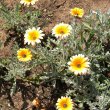
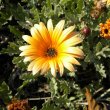
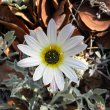
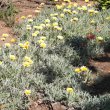
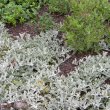


Comments
Arctotis blooming weakly
I have a 30-foot long bed of arctotis planted last spring in eastern San Diego with full sun exposure along a curving block wall facing south. The plants with a more eastern exposure continue to bloom well, but those facing more westerly have smaller and fewer blooms. Should I fertilize the western half, increase the water (drip system) or just wait and see if the poorer blooming plants recover with cooler weather?
Poor flowering of Arctotis
Hi Monte
Isn't that just typical! We plan, we prepare, we plant. We have a vision of masses of flowers sparkling in the sun. Then this happens.
I would certainly increase the drip feed but hesitate about the fertilizer. Arctotis usually grow and flower best in rather depleted soil. Fertiliser tends to encourage leaf and stem growth and the plants may become very leggy without improving the flowering. If you do decide to apply fertilizer, use a slow release organic type and use sparingly. Is it possible that the soil on the westerly side drains faster than the soil on the easterly side? If so, you could also try scattering a bit of mulch between the plants to prevent water loss.
I hope this helps.
Kind regards
Lorraine
Poor flowering of Arctotis
Good tips. I will try the water adjustment and mulch first. Thanks so much.
Discuss this plant
Share knowledge, ask a question or give an experience.